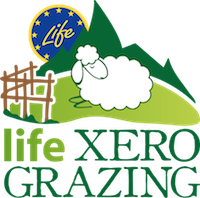Choice of the species
- In Eng
- Hits: 3031
 The choice of animal species (sheep rather than goats, cattle or horses) requires the need to have animals that are suitable for a difficult environment which contains: water scarcity, low-value forage grass and large rocky surfaces, where the periods of use are bound by natural needs and limited to months generally less favorable for other animal species (e.g. February and November).
The choice of animal species (sheep rather than goats, cattle or horses) requires the need to have animals that are suitable for a difficult environment which contains: water scarcity, low-value forage grass and large rocky surfaces, where the periods of use are bound by natural needs and limited to months generally less favorable for other animal species (e.g. February and November).
Whilst goats can meet such requirements and even be more effective in the containment of bushes, sheep will be purchased because they are more manageable and have less potential impact on other components of the habitat. This includes some species that need to be protected (eg, Juniperus oxycedrus).
Furthermore, the area does not lend itself to raising goats that are used for dairy purposes due to the lack of facilities which would impose a more restrictive management. Also, it is known that in the past this land was mainly grazed by sheep and so, despite its abandonment, sheep grazing should be tolerated better by all of the plant communities. Moreover, several studies have demonstrated the effectiveness of the sheep in the dispersal of seeds between different grazing areas that are also spatially isolated, showing positive effects in terms of conservation.
The flock will be composed of young sheep, in an attempt to give more continuity to the project and there will also be a renewal fee provided for the flock, which will be useful over a lengthy time period, for self-financing purposes. As for the type or class of sheep; more resistant species will be used which are more suited to grazing in marginal areas.






